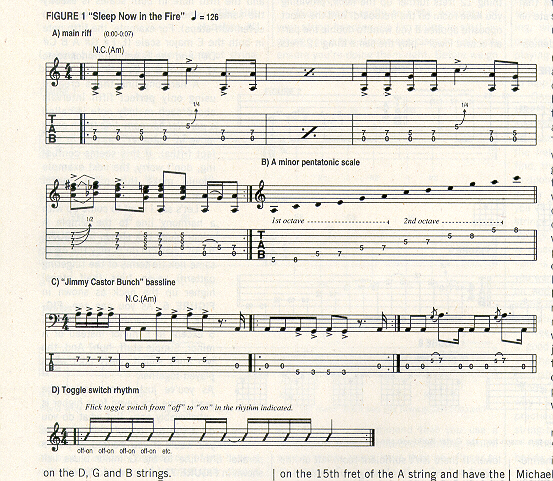Hot Rocks: How to Play Rage Against the Machine's Latest Single, "Sleep Now in the Fire."
"Sleep Now in the Fire" is a song which combines a powerful but simple riff with some unorthodox guitar techniques to make one of my favorite Rage songs.� The main guitar riff (see Figure 1A) is a part that had been bouncing around in my head for quite some time.� We finally put all the pieces together when we were working on our latest album, The Battle of Los Angeles.� This riff is based on the A minor pentatonic scale (see Figure 1B), and incorporates the use of a steadily ringing A string, which functions as a drone (a note that rings continually while other notes are also played).� As you can see and hear, the open A string rings while I play notes on the D, G, and B strings.�
The working title for this song was "MC5" because it has the raw feel of the Stooges or the MC5 mixed with Rage's thunderous rhythm section.� I couldn't help but envision a huge festival audience jumping up and down to this one - it has that kind of feel.� The song really took shape when we married the main guitar riff to a very Seventies, rolling bass line with a dark, lava-lamp, incense-burning, groovy vibe (see Figure 1C).� It reminds me a little of a group from the early Seventies called the Jimmy Castor Bunch.� Big Afros.� Big bass lines.� Timmy and Brad really swing this groove.�
For the verse section, I created this wash of sound that just sits there like a big, fat cloud.� I like this kind of unexpected rhythm guitar part.� Rather than rhythmically supporting the funk, it hovers like an unwelcome dinner guest.� That little combination of note, tone, and Whammy Pedal effect was something I came upon in the studio the day we were recording the song.� I fret the C note on the 15th fret of the A string and have the Whammy Pedal set to harmonize the note a major third below, which drops the note down to A flat.� I just hold the C note, allowing it to sustain, and play another C an octave higher on the 17th fret of the G string every fourth bar.�
For the guitar solo section, I got right up close to the amp to get some feedback and, working the tremolo bar with my left hand, I flicked the toggle switch from the "off" to the "on" position in the rhythm you hear (see Figure 1D).� In order t achieve this toggle switch effect, you'll need a guitar with two pickups, each with its own volume control.� On my guitar, I turn the volume control for the neck pickup all the way down to zero (or "off"), and I turn the volume control for the bridge pickup up full.� This way, when I flick the toggle switch from the neck to the bridge pickup, I am essentially turning the guitar sound from the "off" to the "on" position, then manipulating the pitch with the tremolo bar to make it sound like a whistle, or an angry flute.� With that particular guitar, I always get the same feedback note when I get right up next to the amp, so it's very reliable.�
It sounds like there's a transistor radio mixed in at the end of the song, and that's exactly what it is.� When I was doing overdubs, I was playing my solid-body Ovation Breadwinner guitar through a MusicMan amp, while using an old, vintage distortion pedal called a Tone Bender.� The Tone Bender has a warm, broken-up distortion sound that goes perfectly with the track.� I first got turned on to Tone Benders when we were working on Evil Empire with producer Brendan O'Brien, who also produced our new album.�� I found that when I turned on the pedal but didn't play anything, I picked up a crystal-clear signal from a Korean radio station.� In earlier mixes of "Sleep Now in the Fire," that radio thing was featured more prominently.� We had the radio signal running through the entire song.� It was a little annoying, so we decided just to stick it at the very end.� I always like to say that there are no samples on any of our records, and this is a good example.� That radio signal is no sample - it was played!
I got to demonstrate these techniques the day we shot the video for "Sleep Now in the Fire" on Wall Street in New York City.� Political satirist Michael Moore directed the video.� At the end of the day, he was arrested, and we forced the New York Stock Exchange to close early (at full riot alert!) for the first time in history - proving once and for all that Wall Street is no match for unorthodox guitar playing.�
I'll be back next month with a look at another tune from The Battle of Los Angeles.� See you then.�
